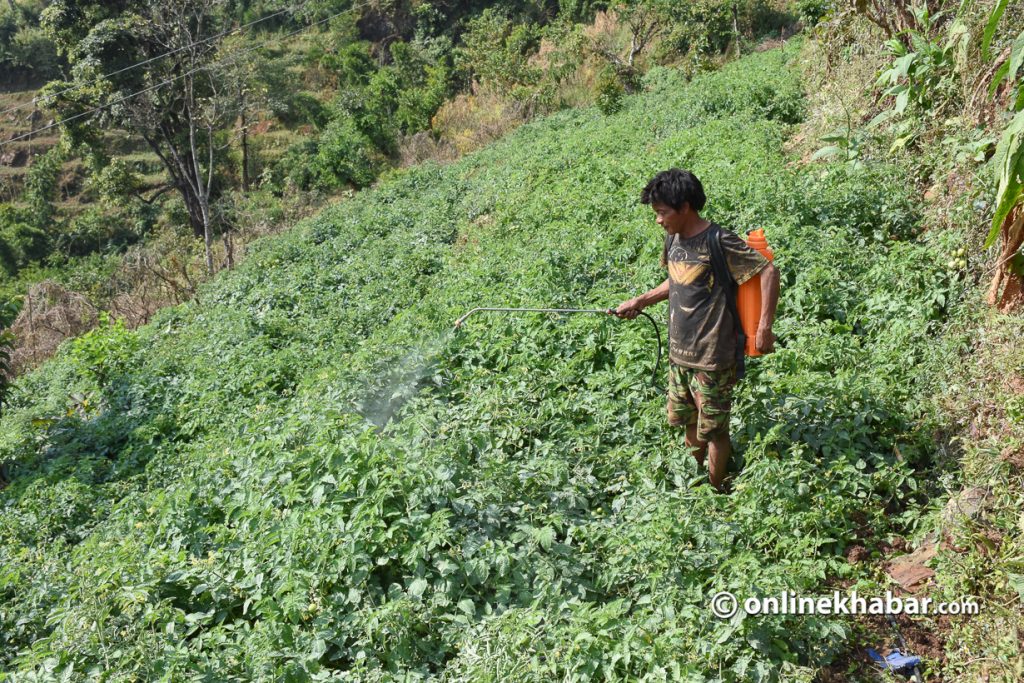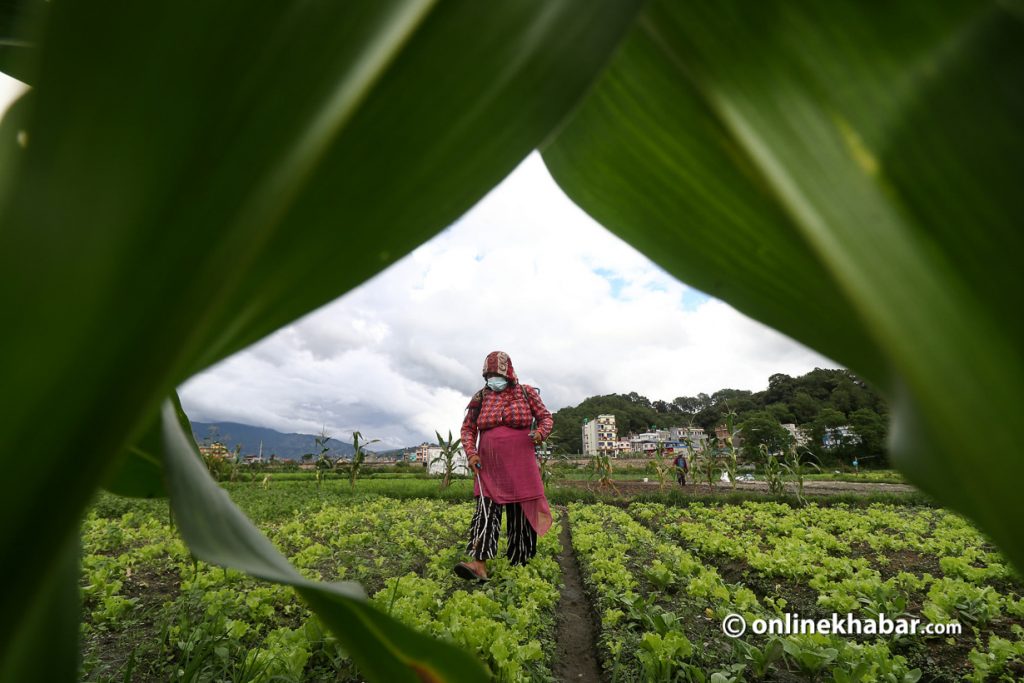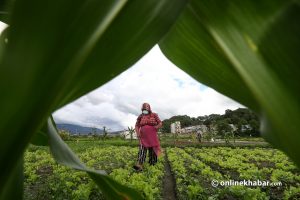
Nepal is primarily an agrarian nation, with a significant 60.4 per cent of its population reliant on agriculture for their livelihoods. The agricultural sector also plays a crucial role in the nation’s economy, contributing 26.8 per cent to its overall economic output.
Furthermore, to stimulate economic growth in Nepal, which is predominantly characterised by subsistence farming, there is a pressing need to promote the commercialisation of agriculture.
Since Nepal entered the World Trade Organization (WTO) as a member country in 2004, it is necessary to explore globalised trade for the nation. However, Nepali farmers’ dependency on pesticides for production might be one of the reasons why Nepal is not being able to explore global trade in agriculture.
History of using pesticides in Nepal
The use of pesticides started in Nepal in the early 1950s to control and eradicate malaria. The first introduced chemicals to Nepal were paris, green, nicotine, sulfates, and DDT and these all were brought from the USA.
These chemicals were followed by others such as organochlorines, organophosphates, carbonates and synthetic pyrethroids. In the agricultural field, pesticides were used in the early sixties. This was the era of the green revolution where farmers were instructed to get maximum yield from a crop by using higher inputs such as improved seeds, chemical fertilisers and pesticides.
The term pesticide covers a wide range of compounds including insecticides, fungicides, herbicides, rodenticides, molluscicides, nematicides, plant growth regulators and others.
Among these, insecticides are used successfully in controlling several diseases, such as malaria and typhus. The role of insecticides in reducing the insect pests’ attack on various crops, and damage to the health of humans and livestock is crucial.
Due to the advantage of the rapid action of these chemicals over target organisms, these are widely being used all over the world and Nepal is no exception in this regard.
Pesticides encompass a broad range of toxic chemicals not only to insects but also to other organisms. Comparatively, the use of pesticides in Nepal is lower than in developed countries, but the real problem is in the commercial pocket areas where growers are using exceedingly more than they need. This unscientific use of pesticides is of major concern not only in Nepal but worldwide.
Contemporary scenario of pesticide use

Pesticide use is reported much higher in vegetables compared to cereal crops and others. Since the vegetable growers are commercial, they tend to use pesticides more often.
It is reported that a higher concentration of pesticides, cypermethrin was detected in tomato and brinjal. The study also showed that the concentration of methamphetamine was higher in cowpeas and was followed by cauliflower, tomato and brinjal.
The residue of carbamate and organophosphate group of pesticides was observed in the vegetables sampled from the leading vegetable markets in Kathmandu, Sarlahi and Kavre districts. The same study has revealed that 21.8 per cent of tomato samples and 18.75 per cent of cowpea samples were among the samples, which were tested positive in pesticide residue analysis using the reagent kit method.
The trend of pesticide use is increasing in Nepal by 10 to 20 per cent per year and this signifies the prevailing crisis of Nepali agriculture not only in terms of economic losses but also of associated detrimental effects.
It is reported that 25 per cent of farmers of plain regions, nine per cent of mid hills and seven per cent of mountains use pesticides in their fields.
It is also reported that pesticide application is significantly higher in cotton plantations in Nepal. Farmers were using two to 15 times more chemicals than necessary in vegetables such as cabbage, potato, tomato, bitter gourd, cucumber etc.
It is even comparable to the share of pesticides in the production of various crops. Farmers are very unaware and they hardly care for the waiting period to pick their harvest before they take it to the market. And these products are purchased by the consumer and immediately taken for their food requirement.
Impact of pesticide use

Pesticides, used in various forms, impact the environment as they can disperse through water, wind, and absorption, posing risks to non-target organisms. Common pesticides often miss their intended targets and may harm non-target species, polluting the environment and potentially endangering human health.
The most harmful pesticides belong to the carbamate and organophosphate groups, which can contaminate soil, surface and groundwater, and various flora and fauna. Accumulating residues of these chemicals pose a moderate risk of cancer to the public.
These practices not only threaten human health but also the rich biodiversity of flora and fauna of the country, including 17,097 species.
Soil-dwelling organisms play a crucial role in maintaining soil health and food production quality, but malpractices with insecticides and other hazardous pesticides can harm these organisms and negatively impact food production. Research in Nepal has found residues of DDT and endosulfan in soil, indicating ongoing pesticide use and past use of these chemicals in the region.
The use of pesticides in agriculture has both positive and negative impacts on production. Pesticides can improve crop yields by protecting plants from pests and diseases. However, their excessive and improper use can lead to several negative consequences, which are explained below.
1. Environmental pollution: Pesticides can contaminate water, soil, and air, leading to environmental degradation. Runoff from fields can carry pesticides to nearby water bodies, impacting aquatic ecosystems and causing harm to fish and other organisms. Pesticides can also leach into groundwater, making it unfit for consumption or agricultural use. Airborne pesticides can harm non-target organisms, including beneficial insects like bees, essential for pollination.
2. Soil degradation: Prolonged use of pesticides can degrade soil quality. Some pesticides, especially persistent ones, can accumulate in soil over time. This leads to a decline in soil biodiversity and affects the beneficial microbes and organisms essential for soil health. This can reduce the long-term productivity and sustainability of agricultural land.
3. Negative impact on biodiversity: Pesticides are designed to kill or control pests, but they can also harm non-target organisms. Insects, birds and other wildlife can be adversely affected by direct exposure to pesticides or through the disruption of their food chain. This can lead to a decline in biodiversity, potentially affecting ecosystem stability and resilience.
4. Human health risks: Pesticides are chemicals designed to kill or manage pests. They can pose risks to human health. Exposure to pesticides, through residues on crops, inhalation, or contaminated water, can lead to acute and chronic health issues in farmers, agricultural workers and nearby communities. Some pesticides have been linked to various health problems, including cancer, neurological disorders, and reproductive issues.
5. Resistance and pest resurgence: Overreliance on pesticides can lead to the development of pest resistance. Repeated use of the same pesticide can select resistant pests, making them less susceptible to control measures. This can result in the need for stronger and more toxic pesticides, creating a vicious cycle. Additionally, when pesticides kill beneficial insects that regulate pest populations, the absence of natural predators can lead to pest resurgence.
6. Food safety concerns: Pesticide residues on crops can pose risks to consumers if they exceed acceptable levels. Stringent regulations are in place to ensure food safety, but the misuse or excessive use of pesticides can lead to residues above permissible limits. This can have adverse effects on human health, particularly in vulnerable populations such as infants and pregnant women.
Need for intervention and awareness programmes
Farmers commonly believe that chemical measures are their sole resource for controlling pests. This perception is driven by a lack of awareness and knowledge among farmers; a scarcity of non-chemical alternatives for pest management and inadequate government regulations and monitoring policies for pesticide use.
These factors collectively contribute to the improper and excessive use of pesticides in Nepal.
However. farmers’ knowledge and behaviour can reduce the ecological risk of pesticides and programmes such as Integrated Pest Management (IPM) training and farmer’s field school (FFS), etc, which could be determined to change the status quo.
Likewise, the Nepal government should prioritise botanical research for safeguarding human health, preserving diverse flora and fauna, and protecting the environment.



















